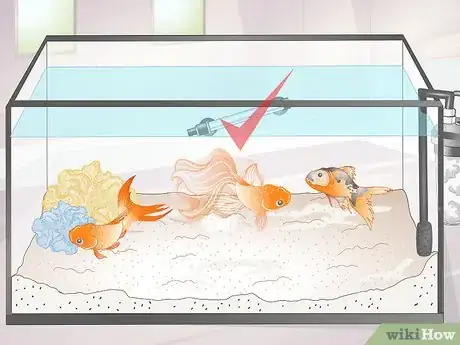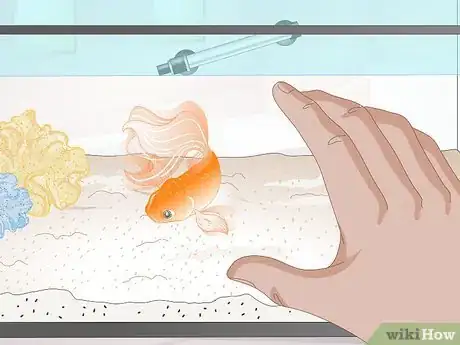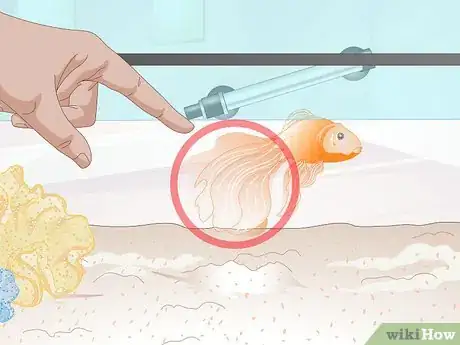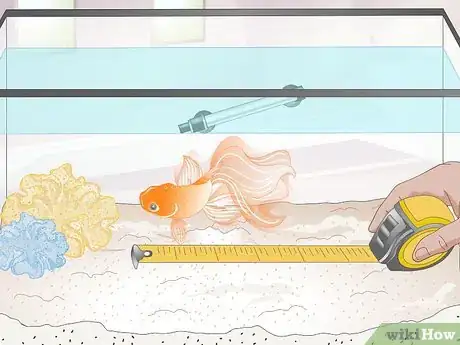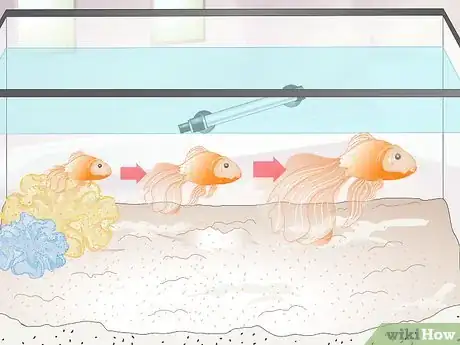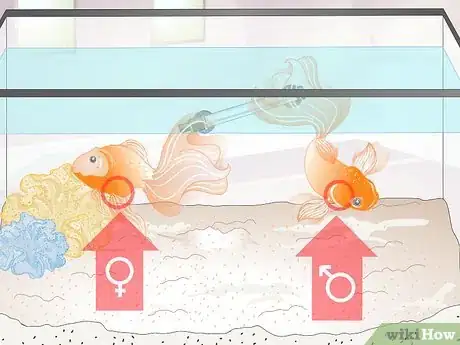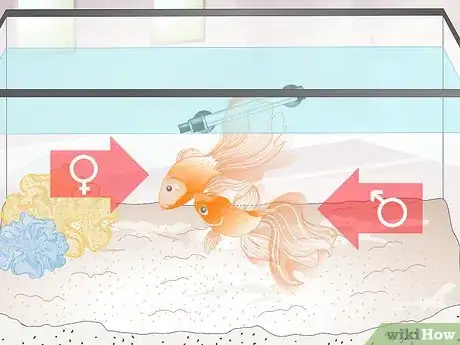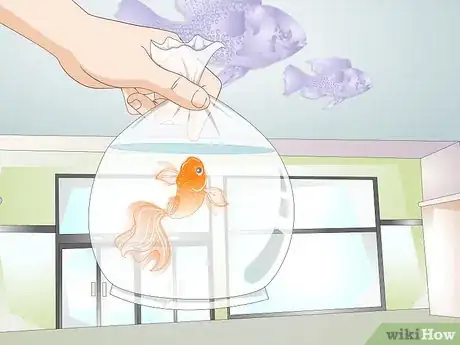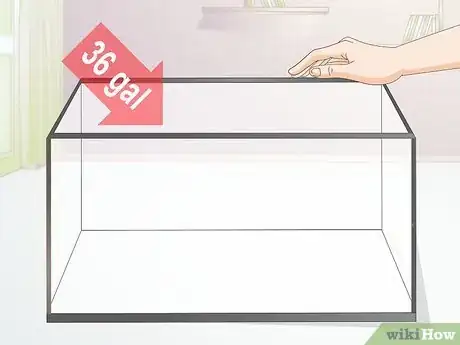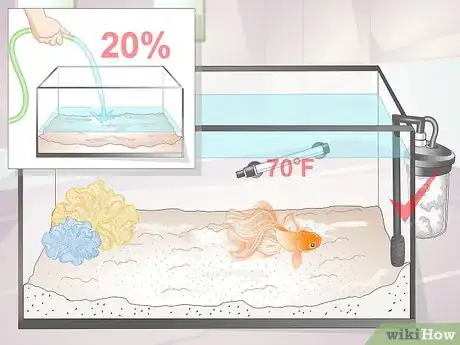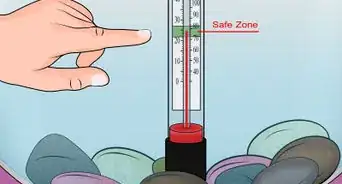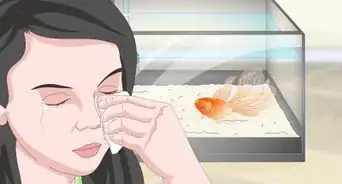This article was co-authored by Pippa Elliott, MRCVS. Dr. Elliott, BVMS, MRCVS is a veterinarian with over 30 years of experience in veterinary surgery and companion animal practice. She graduated from the University of Glasgow in 1987 with a degree in veterinary medicine and surgery. She has worked at the same animal clinic in her hometown for over 20 years.
There are 20 references cited in this article, which can be found at the bottom of the page.
wikiHow marks an article as reader-approved once it receives enough positive feedback. In this case, 84% of readers who voted found the article helpful, earning it our reader-approved status.
This article has been viewed 237,052 times.
Goldfish tend to reach sexual maturity at around a year of age, although they are not fully grown until they are two or three years old.[1] You can see if your goldfish has reached maturity by examining its physical characteristics. You can also determine if the fish is sexually mature or not. If you have had your fish for a while and it has not matured, you may need to make sure that you are providing adequate tank conditions to encourage its growth.
Steps
Examining Your Goldfish
-
1Identify what type of goldfish you have. Different types of goldfish have different characteristics. Understanding what breed you have can help you determine the proper adult coloring and growth for your fish.
- If your goldfish is metallic yellow or orange with white markings, it may be a common or comet goldfish. These are marked by their sharp, forked tail.
- If your goldfish is metallic yellow or orange but has a double, flowing tail, it may be a veiltail or a fantail.
- If your goldfish is black with bulging “telescope” eyes, it is probably a black moor.
- If your fish has calico markings, it is likely a shubunkin. These colors might include orange, white, gray, blue, and yellow with black speckles.[2]
-
2Look at the color. The color of your goldfish can determine its age. It is very common for a goldfish to change color through the course of its life, although it is most common in the first year.
- For most varieties of goldfish, a bronze or brown coloring may indicate that it is under a year old. If it has a gold metallic coloration, it is probably an adult between one or two and ten years of age.[3]
- Black Moor juveniles may be silver or dark gray before darkening to black as adults.[4]
- Shubunkins will be multiple colors, but blue is often the most prominent color in adults.[5]
- Some goldfish begin to turn white as they grow old.
Advertisement -
3Notice the shape of the caudal fin. The caudal fin is the fin at the back of the fish. For most varieties of goldfish, this can indicate the age of the fish. A young goldfish will have a rounded caudal fin. The adult's caudal fin is sharply forked, and the points look well defined.
- Goldfish with flowing tails or double tails will not have a pronounced caudal fin. These include the veiltail and fantail varieties. Instead of changing shape, its tail will grow in length as it grows older. Veiltail's caudal fin can grow up to two inches long as an adult.[6]
-
4Observe its size. If kept in proper tank or pond conditions, a common goldfish will be around 5 inches (12.7 cm) after a year and 9 inches (22.9 cm) after two years.[7] You can eye your goldfish to see how large it has become.
- If you keep your goldfish in a small bowl, you may find that its growth is stunted. In this case, size may not be a good indicator of maturity.[8]
- Some goldfish can grow over 12 inches (30.5 cm) in length.
Determining When Your Fish is Sexually Mature
-
1Wait until it is the proper size. It is impossible to tell the gender or sexual maturity of your fish before it has grown to three inches (eight centimeters) in length. This is typically when the sexual characteristics of your fish begin to develop.[9] Sexual characteristics tend to occur after one year of age, although fish in aquariums may take longer to mature.[10]
-
2Check for physical breeding characteristics. If you are looking to breed your goldfish, you should carefully watch for the development of breeding characteristics at around one year of age.
- Males will develop small white spots on the operculum (gill cover) and the pectoral fin. These white spots are called breeding tubercles.
- A female's abdomen will become fuller and rounder when it is ready to breed.[11]
- While it is impossible to accurately sex your fish before it has developed these physical characteristics, in general, males tend to be smaller and slimmer than females.[12]
-
3Watch for mating behavior. When it is time to mate, male fish will chase the female fish around the tank. It will swim close to the female's abdomen, and you may notice it bumping into the female's stomach area.[13] If you notice hundreds of clear, spherical eggs, your female fish has laid eggs. This is a definite sign of sexual maturity.
Ensuring that Your Fish Reaches Maturity
-
1Consider where you purchased your fish. If you bought your fish from a pet store, it is likely to be small and young. Pet stores may not have given the fish adequate nutrition or space as a young fry, meaning that its growth will be stunted for life. You may also be uncertain of the fish's pedigree; a fish typically only grows as large as its parents. If you want to ensure that your fish reaches its full size or sexual maturity, you should try to buy your goldfish from a breeder.[18]
-
2Provide plenty of space for the fish to grow. Your goldfish's growth may be stunted if it does not have a proper tank. This means that your goldfish may not reach sexual maturity, nor will it reach its full adult size. It is not necessarily the size that does the damage, but the buildup of waste matter in a confined bowl of water. Low oxygen levels in small bowls can also affect your fish's growth.[19]
- A single common Goldfish should be kept in at least 48 gallons (181.7 L) of water. Add 14 gallons (53.0 L) per each additional fish. A single fancy Goldfish can be kept in 36 gallons (136.3 L) with 12 gallons (45.4 L) per each additional fish.[20]
-
3Keep the tank water clean and warm. The water temperature should be between 60 degrees F (15 C) up to the mid 70s (23 C). This is particularly important if you want your fish to reach sexual maturity. Poor water conditions are the primary reason why some goldfish have stunted growth and die young.[21]
- You should replace about 20% of the tank's water every two weeks to keep the water clean.[22]
- A filter in your aquarium will make sure that the water is clean and properly oxygenated.
Warnings
- Do not change water all at once, rather do it over the period of a week, by changing about 1/5 to 1/3 of the tank at a time.⧼thumbs_response⧽
- Do not keep goldfish in bowls, vases, or small tanks. Keeping goldfish in bowls or small tanks will kill your fish. Goldfish require at least 20 gallons per fancy and 40 per single tail!⧼thumbs_response⧽
References
- ↑ http://www.aquaticcommunity.com/goldfish/baby.php
- ↑ http://www.desktopgoldfish.com/goldfish-types.php
- ↑ http://www.fishpondinfo.com/fish/gfbreed.htm
- ↑ https://www.youtube.com/watch?v=055O9oGpuWA&feature=youtu.be&t=91
- ↑ http://thegoldfishtank.com/goldfish-types/shubunkin/goldfish-types-shubunkin-goldfish/
- ↑ http://animal-world.com/encyclo/fresh/goldfish/VeiltailGoldfish.php
- ↑ http://www.fishkeeping.co.uk/articles_74/goldfish-size-life-expectancy.htm
- ↑ http://www.aquaticcommunity.com/goldfish/breeding.php
- ↑ http://www.aquaticcommunity.com/goldfish/breeding.php
- ↑ http://www.fishpondinfo.com/fish/gfsexing.htm
- ↑ http://www.aquaticcommunity.com/goldfish/breeding.php
- ↑ http://www.desktopgoldfish.com/goldfish-types.php?func=fishDetail&fish=Common
- ↑ http://www.aquaticcommunity.com/goldfish/baby.php
- ↑ http://desktopgoldfish.com/page/black-moor
- ↑ http://www.desktopgoldfish.com/goldfish-types.php?func=fishDetail&fish=Shubunkin
- ↑ http://www.desktopgoldfish.com/goldfish-types.php?func=fishDetail&fish=Common
- ↑ http://www.aquaticcommunity.com/goldfish/baby.php
- ↑ http://thegoldfishtank.com/goldfish-info/biology/how-to-influence-goldfish-growth-rate/
- ↑ http://animal-world.com/encyclo/fresh/goldfish/information/gold-fish-care.php
- ↑ http://www.fishkeeping.co.uk/articles_74/goldfish-size-life-expectancy.htm
- ↑ http://www.tfhmagazine.com/details/articles/goldfish-myths-debunked.htm
- ↑ http://www.fishnet.org/goldfish.htm
About This Article
If you want to know if your goldfish is an adult, look at its size, color, and the shape of its back fin. Generally, goldfish over 5 inches long are adults. For most breeds of goldfish, their scales will also change from a bronze or brown color to a gold metallic color when they’re adults. Some breeds turn white or a darker shade when they reach adulthood. Another common sign of adulthood in goldfish is their back fin. While this is usually rounded when they’re young, it will become sharply forked and longer as an adult. For more tips from our Veterinary co-author, including how to figure out the gender of your fish, read on!
